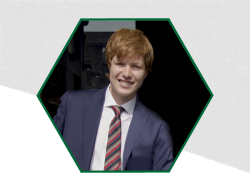Molten pool geometry, whose surface parameters may be extrapolated through direct process observations, has been identified as a fundamental indicator in laser powder bed fusion (LPBF) stability. However, a parameter which cannot be directly measured on industrial systems by means of conventional sensing equipment is the molten pool depth. Indeed, methods based on X-ray imaging demonstrated in literature have helped a better understanding of the process. However, retrofitting such solutions to industrial systems does not appear as a viable option currently. Within the present investigation, a non-intrusive sensing method for the indirect measurement of sub-surface molten pool geometrical attributes based upon the detection of surface oscillations is presented. The analysis of frames acquired using a high speed camera and a secondary illumination light allows the identification of the crests of molten pool capillary waves through bright reflections on the surface of the molten pool. The characteristic oscillation frequency of the surface ripples may be correlated to penetration depth or to other under-surface geometrical parameters.
Proof of concept testing of the sensing principle was conducted on two different materials, namely AISI316L and IN718, by means of single track LPBF depositions. Experiments were conducted at different levels of laser emission power to induce variations in molten pool characteristics. The process was observed employing an off-axis illumination light and a high-speed camera, which allowed acquisitions with high spatial and temporal resolution. The acquired frames were post-processed to extract the oscillation indicator and analysis of the signal power spectral density allowed to identify the oscillation frequency.
Results show that oscillation frequencies ranging from 3 to 5.5 kHz were detected. Molten pool penetration depth and cross-sectional area could be correlated to the oscillation frequencies showing how this approach may be employed for the in-line detection of these parameters during LPBF depositions. For both materials, higher oscillation frequencies corresponded to shallower molten pool and smaller mass of molten material. Moreover, different characteristic curves of oscillation frequency variations as a function of the melt pool cross-sectional area were determined for IN718 and AISI316L.
Keywords
- High Speed Imaging
- Laser Powder Bed Fusion
- Melt Pool
- Monitoring
- Oscillation

